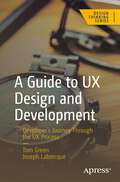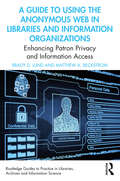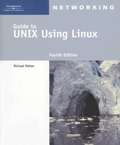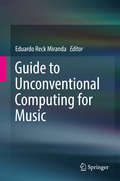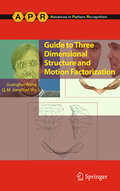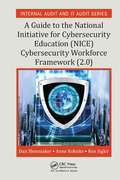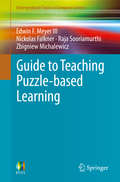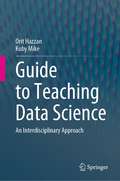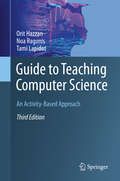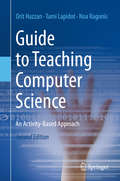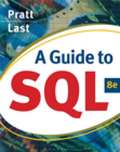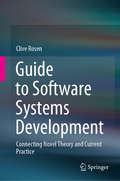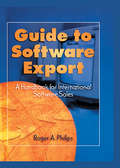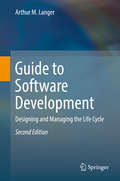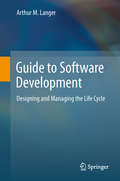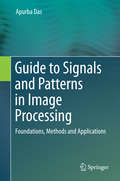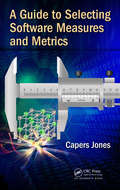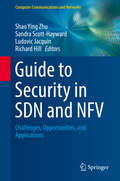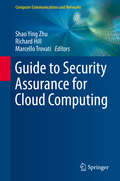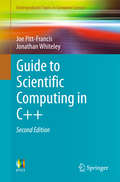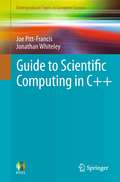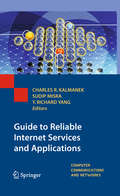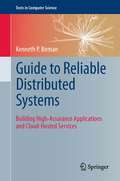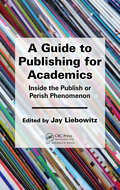- Table View
- List View
A Guide to UX Design and Development: Developer’s Journey Through the UX Process (Design Thinking)
by Tom Green Joseph LabrecqueGain a thorough understanding of the two pillars of any User Experience project: the mission and the process. The mission is to keep the user in mind at each step or milestone as the developer progresses through the project. The process is how that mission is accomplished through collaboration and the use of research, design and development technologies. This book walks you through a developer's journey through the UX process, from start to finish. A Guide to UX Design and Development concentrates on the intersection of what is called “DesignOps” and “DevOps.” That intersection is where collaboration between all members of the team, including stakeholders and clients, occurs and neither DesignOps nor DevOps can go beyond being considered just buzzwords if they instead silo design and development. To highlight the UX Mission and illustrate the responsibility developers also hold for the user experience, authors Tom Green and Joseph Labrecque take you through a hypothetical project involving the development of a parking app for a municipal parking authority. As the book progresses, they concentrate on the developer's journey through the whole project from discovery to product release. In this journey, you will see how developers can make an impact and contribute to the user experience. This will include such topics as why there is a need for both a user journey map and a technical journey map. The authors explain why prototyping is not as complicated as it is made out to be because it is simply an early low-cost and disposable minimal viable product that gives the developer a deep understanding of the project's intent in support of the UX Mission. You will also explore the creation and use of design systems and why the developer's role is just as important as the people who create the design system. The role and responsibility of the developer in user testing is discussed in the context of a variety of testing and assessment methods conducted to achieve the UX mission. Finally, you’ll gain an understanding of how design and development deliverables are negotiated, prepared and sent out for research at each step of the process, and how the developer is involved. What You Will Learn Understand the evolving role of the developer in a team-based environmentLearn the five stages of the UX process Discover the importance of collaboration and communication with stakeholders, designers, and developers at every stage of the processLearn a variety of design and development documents created during the UX process Who This Book Is For Developers and designers involved in the UX Process, as well as developers trying to make sense of the confusing amount of information out there regarding their role in the UX process.
A Guide to Using the Anonymous Web in Libraries and Information Organizations: Enhancing Patron Privacy and Information Access (Routledge Guides to Practice in Libraries, Archives and Information Science)
by Brady D. Lund Matthew A. BeckstromA Guide to Using the Anonymous Web in Libraries and Information Organizations provides practical guidance to those who are interested in integrating the anonymous web into their services. It will be particularly useful to those seeking to promote enhanced privacy for their patrons. The book begins by explaining, in simple terms, what the anonymous web is, how it works, and its benefits for users. Lund and Beckstrom also explain why they believe access to the anonymous web should be provided in library and information organizations around the world. They describe how to provide access, as well as educate library users on how to utilize the anonymous web and navigate any challenges that might arise during implementation. The authors also encourage the development of library policies that guide appropriate conduct and filter content, where appropriate, in order to deter illegal activity. A Guide to Using the Anonymous Web in Libraries and Information Organizations reminds us that libraries and other information providers have a duty to educate and support their communities, while also preserving privacy. Demonstrating that the anonymous web can help them to fulfil these obligations, this book will be essential reading for library and information professionals working around the world.
Guide to UNIX Using Linux, Fourth Edition
by Michael PalmerGuide to UNIX Using Linux, Fourth Edition is updated to include new UNIX/Linux distributions, networking utilities, new UNIX/Linux capabilities, and coverage of both the GNOME and KDE desktops. The large array of commands, utilities, file systems, and other information you learn here applies to any Linux system and most UNIX systems. Within the book four modern Linux operating systems are spotlighted as examples: Fedora, Red Hat Enterprise Linux, SUSE, and Knoppix.
Guide to Unconventional Computing for Music
by Eduardo Reck MirandaThis pioneering text/reference explores how innovative new modes of computation may provide exciting new directions for future developments in the music industry, guiding the reader through the latest research in this emerging, interdisciplinary field. This work includes coverage of electronic music compositions and performances that incorporate unconventional interfacing, hacking and circuit bending. Features: presents an introduction to unconventional computing in music; discusses initiatives involving biophysical electronic music, the work of self-styled silicon luthiers, and the intersection of music and quantum computing; introduces the memristor, a new electronic component with the potential to revolutionize how computers are built; reviews experiments and practical applications of biological memristors in music; describes IMUSIC, an unconventional tone-based programming language, which enables the programming of computers using musical phrases; includes review questions at the end of each chapter.
Guide to Three Dimensional Structure and Motion Factorization
by Guanghui Wang Jonathan WuThe problem of structure and motion recovery from image sequences is an important theme in computer vision. Considerable progress has been made in this field during the past two decades, resulting in successful applications in robot navigation, augmented reality, industrial inspection, medical image analysis, and digital entertainment, among other areas. However, many of these methods work only for rigid objects and static scenes. The study of non-rigid structure from motion is not only of academic significance, but also has important practical applications in real-world, nonrigid or dynamic scenarios, such as human facial expressions and moving vehicles. This practical guide/reference provides a comprehensive overview of Euclidean structure and motion recovery, with a specific focus on factorization-based algorithms. The book discusses the latest research in this field, including the extension of the factorization algorithm to recover the structure of non-rigid objects, and presents some new algorithms developed by the authors. Readers require no significant knowledge of computer vision, although some background on projective geometry and matrix computation would be beneficial. Topics and features: presents the first systematic study of structure and motion recovery of both rigid and non-rigid objects from images sequences; discusses in depth the theory, techniques, and applications of rigid and non-rigid factorization methods in three dimensional computer vision; examines numerous factorization algorithms, covering affine, perspective and quasi-perspective projection models; provides appendices describing the mathematical principles behind projective geometry, matrix decomposition, least squares, and nonlinear estimation techniques; includes chapter-ending review questions, and a glossary of terms used in the book. This unique text offers practical guidance in real applications and implementations of 3D modeling systems for practitioners in computer vision and pattern recognition, as well as serving as an invaluable source of new algorithms and methodologies for structure and motion recovery for graduate students and researchers.
A Guide to the National Initiative for Cybersecurity Education: A Guide To The National Initiative For Cybersecurity Education (nice) Framework (2. 0) (Security, Audit and Leadership Series)
by Dan Shoemaker Anne Kohnke Ken SiglerA Guide to the National Initiative for Cybersecurity Education (NICE) Cybersecurity Workforce Framework (2.0) presents a comprehensive discussion of the tasks, knowledge, skill, and ability (KSA) requirements of the NICE Cybersecurity Workforce Framework 2.0. It discusses in detail the relationship between the NICE framework and the NIST’s cybersecurity framework (CSF), showing how the NICE model specifies what the particular specialty areas of the workforce should be doing in order to ensure that the CSF’s identification, protection, defense, response, or recovery functions are being carried out properly. The authors construct a detailed picture of the proper organization and conduct of a strategic infrastructure security operation, describing how these two frameworks provide an explicit definition of the field of cybersecurity. The book is unique in that it is based on well-accepted standard recommendations rather than presumed expertise. It is the first book to align with and explain the requirements of a national-level initiative to standardize the study of information security. Moreover, it contains knowledge elements that represent the first fully validated and authoritative body of knowledge (BOK) in cybersecurity. The book is divided into two parts: The first part is comprised of three chapters that give you a comprehensive understanding of the structure and intent of the NICE model, its various elements, and their detailed contents. The second part contains seven chapters that introduce you to each knowledge area individually. Together, these parts help you build a comprehensive understanding of how to organize and execute a cybersecurity workforce definition using standard best practice.
Guide to Teaching Puzzle-based Learning
by Edwin F. Meyer Nickolas Falkner Raja Sooriamurthi Zbigniew MichalewiczThis book provides insights drawn from the authors' extensive experience in teaching Puzzle-based Learning. Practical advice is provided for teachers and lecturers evaluating a range of different formats for varying class sizes. Features: suggests numerous entertaining puzzles designed to motivate students to think about framing and solving unstructured problems; discusses models for student engagement, setting up puzzle clubs, hosting a puzzle competition, and warm-up activities; presents an overview of effective teaching approaches used in Puzzle-based Learning, covering a variety of class activities, assignment settings and assessment strategies; examines the issues involved in framing a problem and reviews a range of problem-solving strategies; contains tips for teachers and notes on common student pitfalls throughout the text; provides a collection of puzzle sets for use during a Puzzle-based Learning event, including puzzles that require probabilistic reasoning, and logic and geometry puzzles.
Guide to Teaching Data Science: An Interdisciplinary Approach
by Orit Hazzan Koby MikeData science is a new field that touches on almost every domain of our lives, and thus it is taught in a variety of environments. Accordingly, the book is suitable for teachers and lecturers in all educational frameworks: K-12, academia and industry.This book aims at closing a significant gap in the literature on the pedagogy of data science. While there are many articles and white papers dealing with the curriculum of data science (i.e., what to teach?), the pedagogical aspect of the field (i.e., how to teach?) is almost neglected. At the same time, the importance of the pedagogical aspects of data science increases as more and more programs are currently open to a variety of people.This book provides a variety of pedagogical discussions and specific teaching methods and frameworks, as well as includes exercises, and guidelines related to many data science concepts (e.g., data thinking and the data science workflow), main machine learning algorithms and concepts (e.g., KNN, SVM, Neural Networks, performance metrics, confusion matrix, and biases) and data science professional topics (e.g., ethics, skills and research approach).Professor Orit Hazzan is a faculty member at the Technion’s Department of Education in Science and Technology since October 2000. Her research focuses on computer science, software engineering and data science education. Within this framework, she studies the cognitive and social processes on the individual, the team and the organization levels, in all kinds of organizations.Dr. Koby Mike is a Ph.D. graduate from the Technion's Department of Education in Science and Technology under the supervision of Professor Orit Hazzan. He continued his post-doc research on data science education at the Bar-Ilan University, and obtained a B.Sc. and an M.Sc. in Electrical Engineering from Tel Aviv University.
Guide to Teaching Computer Science: An Activity-Based Approach
by Orit Hazzan Noa Ragonis Tami LapidotThis concise yet thorough textbook presents an active-learning model for the teaching of computer science. Offering both a conceptual framework and detailed implementation guidelines, the work is designed to support a Methods of Teaching Computer Science (MTCS) course, but may be applied to the teaching of any area of computer science at any level, from elementary school to university. This text is not limited to any specific curriculum or programming language, but instead suggests various options for lesson and syllabus organization.Fully updated and revised, the third edition features more than 40 new activities, bringing the total to more than 150, together with new chapters on computational thinking, data science, and soft concepts and soft skills. This edition also introduces new conceptual frameworks for teaching such as the MERge model, and new formats for the professional development of computer science educators.Topics and features: includes an extensive set of activities, to further support the pedagogical principles outlined in each chapter; discusses educational approaches to computational thinking, how to address soft concepts and skills in a MTCS course, and the pedagogy of data science (NEW); focuses on teaching methods, lab-based teaching, and research in computer science education, as well as on problem-solving strategies; examines how to recognize and address learners’ misconceptions, and the different types of questions teachers can use to vary their teaching methods; provides coverage of assessment, teaching planning, and designing a MTCS course; reviews high school teacher preparation programs, and how prospective teachers can gain experience in teaching computer science.This easy-to-follow textbook and teaching guide will prove invaluable to computer science educators within all frameworks, including university instructors and high school teachers, as well as to instructors of computer science teacher preparation programs.
Guide to Teaching Computer Science
by Tami Lapidot Orit Hazzan Noa RagonisThis guide presents both a conceptual framework and detailed implementation guidelines for general computer science (CS) teaching. The content is clearly written and structured to be applicable to all levels of CS education and for any teaching organization, without limiting its focus to instruction for any specific curriculum, programming language or paradigm. Features: presents an overview of research in CS education; examines strategies for teaching problem-solving, evaluating pupils, and for dealing with pupils' misunderstandings; provides learning activities throughout the book; proposes active-learning-based classroom teaching methods, as well as methods specifically for lab-based teaching; discusses various types of questions that a CS instructor, tutor, or trainer can use for a range of different teaching situations; investigates thoroughly issues of lesson planning and course design; describes frameworks by which prospective CS teachers gain their first teaching experience.
A Guide to SQL (Eighth Edition)
by Philip J. Pratt Mary Z. LastA GUIDE TO SQL, 8E, continues to be the essential SQL reference. It builds on the success of previous editions by presenting basic SQL commands in the context of a running case in which a business uses SQL to manage orders, parts, customers, and sales reps. The book covers the fundamentals of SQL programming using straightforward instruction and extensive hands-on exercises. Continuing with its focus on learning the basics regardless of the database environment chosen, this edition features examples from the latest databases: Oracle 11g, Access 2007, and MySQL. The eighth edition expands on the use of running case studies by adding a third running case to the extensive hands-on pedagogy at the end of every chapter.
Guide to Software Systems Development: Connecting Novel Theory and Current Practice
by Clive RosenThis book argues that the key problems of software systems development (SSD) are socio-technical rather than purely technical in nature. Software systems are unique. They are the only human artefacts that are both intangible and determinant. This presents unprecedented problems for the development process both in determining what is required and how it is developed. Primarily this is a problem of communications between stakeholders and developers, and of communications within the development team. Current solutions are not only inadequate in expressing the technical problem, they also evade the communications problems almost entirely.Whilst the book addresses the theoretical aspects of the process, its fundamental philosophy is anchored in the practical problems of everyday software development. It therefore offers both a better understanding of the problems of SSD and practical suggestions of how to deal with those problems. It is intended as a guide for practising IT project managers, particularly those who are relatively new to the position or do not have a strong IT development background. The book will also benefit students in computing and computer-related disciplines who need to know how to develop high quality systems.Software systems development (particularly of large projects) has a notoriously poor track record of delivering projects on time, on budget, and of meeting user needs. Proponents of software engineering suggest that this is because too few project managers actually comply with the disciplines demanded of the process. It is time to ask the question, if this is the case, why might this be? Perhaps instead, it is not the project managers who are wrong, but the definition of the process. The new understanding of the SSD presented here offers alternative models that can help project managers address the difficulties they face and better achieve the targets they are set. This book argues that time is up for the software engineering paradigm of SSD and that it should be replaced with a socio-technical paradigm based on open systems thinking.
Guide To Software Export: A Handbook For International Software Sales
by Roger A. PhilipsAn ideal reference source for CEOs, marketing and sales managers, sales consultants, and students of international marketing, Guide to Software Export provides a step-by-step approach to initiating or expanding international software sales. It teaches you how to examine critically your candidate product for exportability; how to find distributors, agents, and resellers abroad; how to identify the best distribution structure for export; and much, much more!Not content with providing just the guidelines for setting up, expanding, and managing your international sales channels, Guide to Software Export advises you on pitfalls to avoid, important legal and financial considerations associated with software export, and essential market and distribution information. In an effort to cover all the bases, this comprehensive text also discusses: negotiating partnerships electronic marketing evaluating the competition cultural assumptions and biases adapting software for use in Asian markets information sources on the Internet distribution channel strategiesIf you’re not satisfied with your company’s international sales performance or you want to get into the global market, Guide to Software Export can help you guide your company through the transition. With the book’s easy-to-follow advice and checkpoints, you are sure to bring new levels of success to your company, so act now and get out in the forefront of software exporting.
Guide to Software Development
by Arthur M. LangerThis book presents a guide to navigating the complicated issues of quality and process improvement in enterprise software implementation, and the effect these have on the software development life cycle (SDLC). Offering an integrated approach that includes important management and decision practices, the text explains how to create successful automated solutions that fit user and customer needs, by mixing different SDLC methodologies. With an emphasis on the realities of practice, the book offers essential advice on defining business requirements, and managing change. This revised and expanded second edition includes new content on such areas as cybersecurity, big data, and digital transformation. Features: presents examples, case studies, and chapter-ending problems and exercises; concentrates on the skills needed to distinguish successful software implementations; considers the political and cultural realities in organizations; suggests many alternatives for how to manage and model a system.
Guide to Software Development
by Arthur M. LangerThis book addresses how best to make build vs. buy decisions, and what effect such decisions have on the software development life cycle (SDLC). Offering an integrated approach that includes important management and decision practices, the text explains how to create successful solutions that fit user and customer needs, by mixing different SDLC methodologies. Features: provides concrete examples and effective case studies; focuses on the skills and insights that distinguish successful software implementations; covers management issues as well as technical considerations, including how to deal with political and cultural realities in organizations; identifies many new alternatives for how to manage and model a system using sophisticated analysis tools and advanced management practices; emphasizes how and when professionals can best apply these tools and practices, and what benefits can be derived from their application; discusses searching for vendor solutions, and vendor contract considerations.
Guide to Signals and Patterns in Image Processing
by Apurba DasThis text reviews the field of digital image processing from the different perspectives offered by the separate domains of signal processing and pattern recognition. The book describes a rich array of applications, representing the latest trends in industry and academic research. To inspire further interest in the field, a selection of worked-out numerical problems is also included in the text. The content is presented in an accessible manner, examining each topic in depth without assuming any prior knowledge from the reader, and providing additional background material in the appendices. Features: covers image enhancement techniques in the spatial domain, the frequency domain, and the wavelet domain; reviews compression methods and formats for encoding images; discusses morphology-based image processing; investigates the modeling of object recognition in the human visual system; provides supplementary material, including MATLAB and C++ code, and interactive GUI-based modules, at an associated website.
A Guide to Selecting Software Measures and Metrics
by Capers JonesGoing where no book on software measurement and metrics has previously gone, this critique thoroughly examines a number of bad measurement practices, hazardous metrics, and huge gaps and omissions in the software literature that neglect important topics in measurement. The book covers the major gaps and omissions that need to be filled if data about software development is to be useful for comparisons or estimating future projects. Among the more serious gaps are leaks in reporting about software development efforts that, if not corrected, can distort data and make benchmarks almost useless and possibly even harmful. One of the most common leaks is that of unpaid overtime. Software is a very labor-intensive occupation, and many practitioners work very long hours. However, few companies actually record unpaid overtime. This means that software effort is underreported by around 15%, which is too large a value to ignore. Other sources of leaks include the work of part-time specialists who come and go as needed. There are dozens of these specialists, and their combined effort can top 45% of total software effort on large projects. The book helps software project managers and developers uncover errors in measurements so they can develop meaningful benchmarks to estimate software development efforts. It examines variations in a number of areas that include: Programming languages Development methodology Software reuse Functional and nonfunctional requirements Industry type Team size and experience Filled with tables and charts, this book is a starting point for making measurements that reflect current software development practices and realities to arrive at meaningful benchmarks to guide successful software projects.
Guide to Security in SDN and NFV
by Shao Ying Zhu Sandra Scott-Hayward Ludovic Jacquin Richard HillThis book highlights the importance of security in the design, development and deployment of systems based on Software-Defined Networking (SDN) and Network Functions Virtualization (NFV), together referred to as SDNFV. Presenting a comprehensive guide to the application of security mechanisms in the context of SDNFV, the content spans fundamental theory, practical solutions, and potential applications in future networks. Topics and features: introduces the key security challenges of SDN, NFV and Cloud Computing, providing a detailed tutorial on NFV security; discusses the issue of trust in SDN/NFV environments, covering roots of trust services, and proposing a technique to evaluate trust by exploiting remote attestation; reviews a range of specific SDNFV security solutions, including a DDoS detection and remediation framework, and a security policy transition framework for SDN; describes the implementation of a virtual home gateway, and a project that combines dynamic security monitoring with big-data analytics to detect network-wide threats; examines the security implications of SDNFV in evolving and future networks, from network-based threats to Industry 4. 0 machines, to the security requirements for 5G; investigates security in the Observe, Orient, Decide and Act (OODA) paradigm, and proposes a monitoring solution for a Named Data Networking (NDN) architecture; includes review questions in each chapter, to test the reader's understanding of each of the key concepts described. This informative and practical volume is an essential resource for researchers interested in the potential of SDNFV systems to address a broad range of network security challenges. The work will also be of great benefit to practitioners wishing to design secure next-generation communication networks, or to develop new security-related mechanisms for SDNFV systems.
Guide to Security Assurance for Cloud Computing
by Shao Ying Zhu Richard Hill Marcello TrovatiThis practical and didactic text/reference discusses the leading edge of secure cloud computing, exploring the essential concepts and principles, tools, techniques and deployment models in this field. Enlightening perspectives are presented by an international collection of pre-eminent authorities in cloud security assurance from both academia and industry. Topics and features: · Describes the important general concepts and principles of security assurance in cloud-based environments · Presents applications and approaches to cloud security that illustrate the current state of the art · Reviews pertinent issues in relation to challenges that prevent organizations moving to cloud architectures · Provides relevant theoretical frameworks and the latest empirical research findings · Discusses real-world vulnerabilities of cloud-based software in order to address the challenges of securing distributed software · Highlights the practicalities of cloud security, and how applications can assure and comply with legislation · Includes review questions at the end of each chapter This Guide to Security Assurance for Cloud Computing will be of great benefit to a broad audience covering enterprise architects, business analysts and leaders, IT infrastructure managers, cloud security engineers and consultants, and application developers involved in system design and implementation. The work is also suitable as a textbook for university instructors, with the outline for a possible course structure suggested in the preface. The editors are all members of the Computing and Mathematics Department at the University of Derby, UK, where Dr. Shao Ying Zhu serves as a Senior Lecturer in Computing, Dr. Richard Hill as a Professor and Head of the Computing and Mathematics Department, and Dr. Marcello Trovati as a Senior Lecturer in Mathematics. The other publications of the editors include the Springer titles Big-Data Analytics and Cloud Computing, Guide to Cloud Computing and Cloud Computing for Enterprise Architectures.
Guide to Scientific Computing in C++ (Undergraduate Topics in Computer Science)
by Jonathan Whiteley Joe Pitt-FrancisThis simple-to-follow textbook/reference provides an invaluable guide to object-oriented C++ programming for scientific computing. Through a series of clear and concise discussions, the key features most useful to the novice programmer are explored, enabling the reader to quickly master the basics and build the confidence to investigate less well-used features when needed. The text presents a hands-on approach that emphasizes the benefits of learning by example, stressing the importance of a clear programming style to minimise the introduction of errors into the code, and offering an extensive selection of practice exercises.This updated and enhanced new edition includes additional material on software testing, and on some new features introduced in modern C++ standards such as C++11.Topics and features: presents a practical treatment of the C++ programming language for applications in scientific computing; reviews the essentials of procedural programming in C++, covering variables, flow of control, input and output, pointers, functions and reference variables; introduces the concept of classes, showcasing the main features of object-orientation, and discusses such advanced C++ features as templates and exceptions; examines the development of a collection of classes for linear algebra calculations, and presents an introduction to parallel computing using MPI; describes how to construct an object-oriented library for solving second order differential equations; contains appendices reviewing linear algebra and useful programming constructs, together with solutions to selected exercises; provides exercises and programming tips at the end of every chapter, and supporting code at an associated website.This accessible textbook is a “must-read” for programmers of all levels of expertise. Basic familiarity with concepts such as operations between vectors and matrices, and the Newton-Raphson method for finding the roots of non-linear equations, would be an advantage, but extensive knowledge of the underlying mathematics is not assumed.
Guide to Scientific Computing in C++
by Jonathan Whiteley Joe Pitt-FrancisThis easy-to-read textbook/reference presents an essential guide to object-oriented C++ programming for scientific computing. With a practical focus on learning by example, the theory is supported by numerous exercises. Features: provides a specific focus on the application of C++ to scientific computing, including parallel computing using MPI; stresses the importance of a clear programming style to minimize the introduction of errors into code; presents a practical introduction to procedural programming in C++, covering variables, flow of control, input and output, pointers, functions, and reference variables; exhibits the efficacy of classes, highlighting the main features of object-orientation; examines more advanced C++ features, such as templates and exceptions; supplies useful tips and examples throughout the text, together with chapter-ending exercises, and code available to download from Springer.
Guide to Reliable Internet Services and Applications
by Charles R. Kalmanek Sudip Misra Yang Richard YangThis guide addresses the challenges faced by service providers and the approaches they use to deliver reliable networks and networked application services. The book offers a systematic, inter-disciplinary approach and coverage of practical problems arising in real, operational deployments. Leading practitioners and researchers present their perspectives, and provide "best practices". Features: Introduces the challenges of building reliable networks and services; Examines network reliability modeling and network planning; Investigates inter-domain reliability and overlay networks; Explores the critical function of network configuration management; Discusses network measurement and performance monitoring; Covers network management systems; Presents an approach to the design of reliable network application software, and an overview of server capacity and performance engineering. This text is suitable for an advanced undergraduate or graduate course, and will be of value to researchers and practitioners.
Guide to Reliable Distributed Systems
by Kenneth P. BirmanThis book describes the key concepts, principles and implementation options for creating high-assurance cloud computing solutions. The guide starts with a broad technical overview and basic introduction to cloud computing, looking at the overall architecture of the cloud, client systems, the modern Internet and cloud computing data centers. It then delves into the core challenges of showing how reliability and fault-tolerance can be abstracted, how the resulting questions can be solved, and how the solutions can be leveraged to create a wide range of practical cloud applications. The author's style is practical, and the guide should be readily understandable without any special background. Concrete examples are often drawn from real-world settings to illustrate key insights. Appendices show how the most important reliability models can be formalized, describe the API of the Isis2 platform, and offer more than 80 problems at varying levels of difficulty.
A Guide to Publishing for Academics: Inside the Publish or Perish Phenomenon
by Jay LiebowitzMost academics still wrestle with the "publish or perish" phenomenon. Based on Dr. Liebowitz's 25 years serving as the editor-in-chief of a leading international journal, along with insights from some of the most knowledgeable journal editors, this book shares key lessons learned to help new professors, doctoral students, and practitioner-scholars
A Guide to Programming in Java: Java 2 Platform Standard Edition 5
by Beth BrownThe book is intended to provide introduction to programming using Java and to prepare students for further study in the programming/computer science field.
